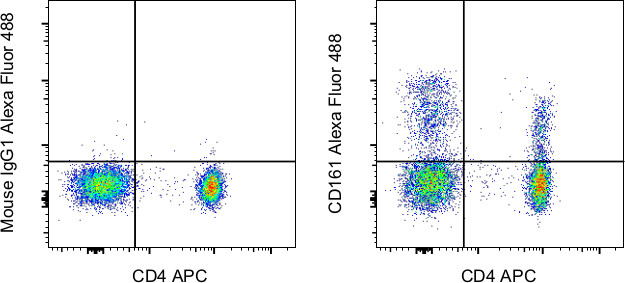Search Thermo Fisher Scientific
Invitrogen
CD161 Monoclonal Antibody (HP-3G10), Alexa Fluor™ 488, eBioscience™
FIGURE: 1 / 1
CD161 Antibody (53-1619-42) in Flow

Product Details
53-1619-42
Species Reactivity
Published species
Host/Isotype
Recommended Isotype Control
Class
Type
Clone
Conjugate
Excitation/Emission Max
Form
Concentration
Purification
Storage buffer
Contains
Storage conditions
Shipping conditions
RRID
Product Specific Information
Description: This HP-3G10 monoclonal antibody reacts with CD161 (also known as NKR-P1A), a member of the C-type lectin superfamily. The human homologue of NK1.1 in C57BL/6 mice, CD161 is expressed on natural killer cells and is upregulated in response to IL-12. CD161 can also be detected on various T cell subsets, including memory/effector CD4+ T cells, CD8+ T cells, gamma delta TCR T cells, and a subset of CD3+ thymocytes. Finally, CD161 expression has been demonstrated on human Th17 CD4+ T cells. The function of this receptor is unclear although studies suggest a possible stimulatory role. Nevertheless, Lectin-like transcript-1 (LLT1), which is also known as osteoclast inhibitory lectin, has been identified as the ligand for CD161.
Applications Reported: This HP-3G10 antibody has been reported for use in flow cytometric analysis.
Applications Tested: This HP-3G10 antibody has been pre-titrated and tested by flow cytometric analysis of normal human peripheral blood cells. This can be used at 5 µL (0.25 µg) per test. A test is defined as the amount (µg) of antibody that will stain a cell sample in a final volume of 100 µL. Cell number should be determined empirically but can range from 10^5 to 10^8 cells/test.
Excitation: 488 nm; Emission: 519 nm; Laser: Blue Laser.
Filtration: 0.2 µm post-manufacturing filtered.
Target Information
KLRB1 (Killer cell lectin like receptor subfamily B, member 1, CD-161) protein is classified as a type II membrane protein because it has an external C terminus. KLRB1 cell surface antigen is expressed by almost all NK cells and in a small subset of CD3+ve T cells. KLRB1 is a homodimeric cell surface protein, comprising two chains with molecular weights ranging from 40-44kDa. KLRB1 plays an inhibitory role on natural killer (NK) cells. Activation of KLRB1 leads to acid sphingomyelnase/SMPD1 stimulation and an increase in intracellular ceramide. Moreover, there is also an activation of AKT1/PKB and RPS6KA1/RSK1 kinase stimulation, and T cell proliferation by anti-CD3. KLRB1 acts as a lectin that binds to the terminal carbohydrate Gal-alpha(1,3)Gal epitope and to the N-acetyllactosamine epitope. KLRB1 also binds to CLEC2D/LLT1 as a ligand, and inhibits NK cell-mediated cytotoxicity as well as interferon-gamma secretion in target cells. The KLRB1 protein contains an extracellular domain with several motifs characteristic of C-type lectins, a transmembrane domain, and a cytoplasmic domain.
For Research Use Only. Not for use in diagnostic procedures. Not for resale without express authorization.
How to use the Panel Builder
Watch the video to learn how to use the Invitrogen Flow Cytometry Panel Builder to build your next flow cytometry panel in 5 easy steps.
Bioinformatics
Protein Aliases: C-type lectin domain family 5 member B; CD161; HNKR-P1a; Killer cell lectin-like receptor subfamily B member 1; killer cell lectin-like receptor subfamily B, member 1; MGC138614; natural killer cell receptor; Natural killer cell surface protein P1A; NKR-P1A
Gene Aliases: CD161; CLEC5B; hNKR-P1A; KLRB1; NKR; NKR-P1; NKR-P1A; NKRP1A
UniProt ID: (Human) Q12918
Entrez Gene ID: (Human) 3820

Performance Guarantee
If an Invitrogen™ antibody doesn't perform as described on our website or datasheet,we'll replace the product at no cost to you, or provide you with a credit for a future purchase.*
Learn more
We're here to help
Get expert recommendations for common problems or connect directly with an on staff expert for technical assistance related to applications, equipment and general product use.
Contact tech support

